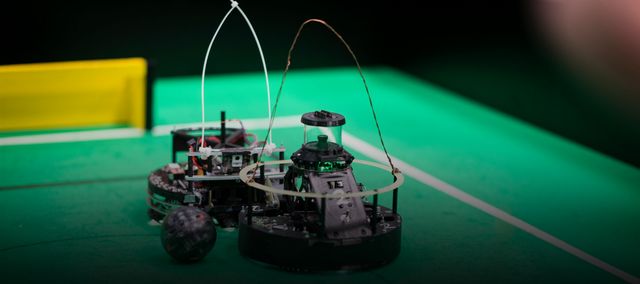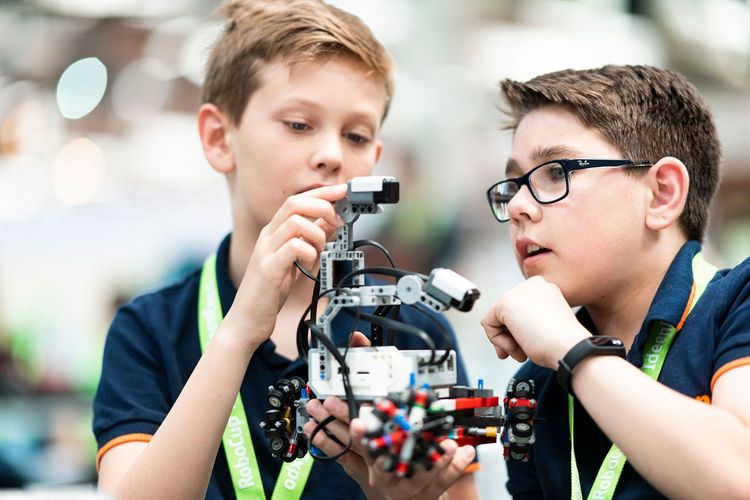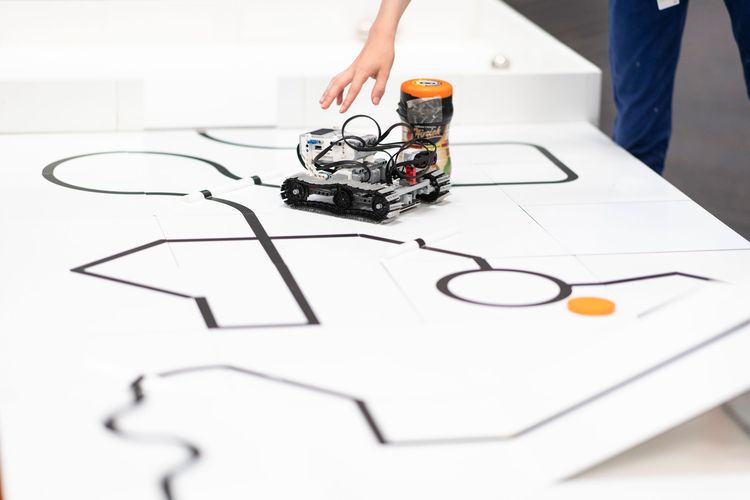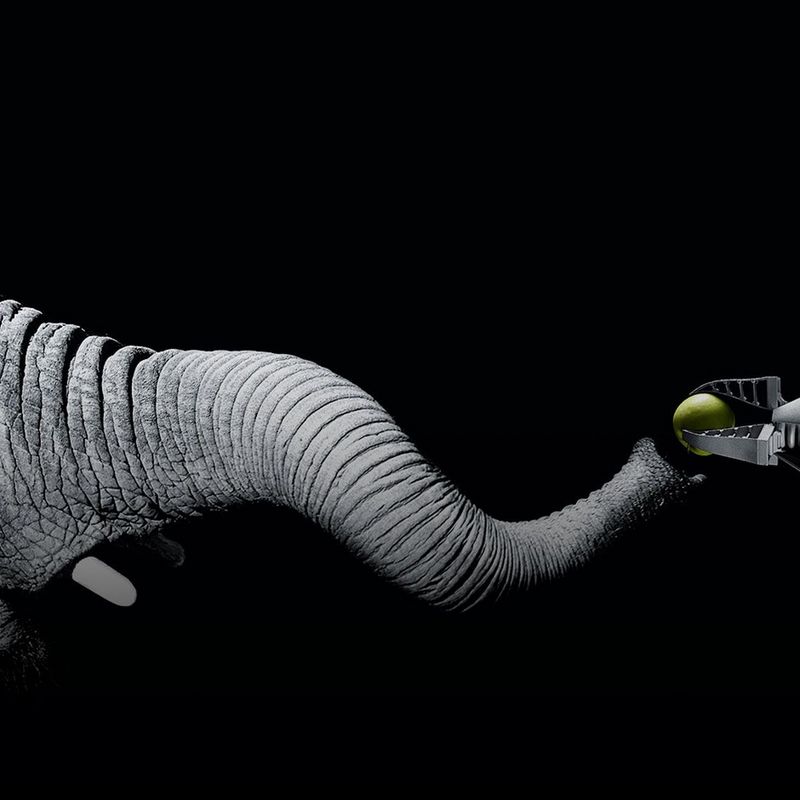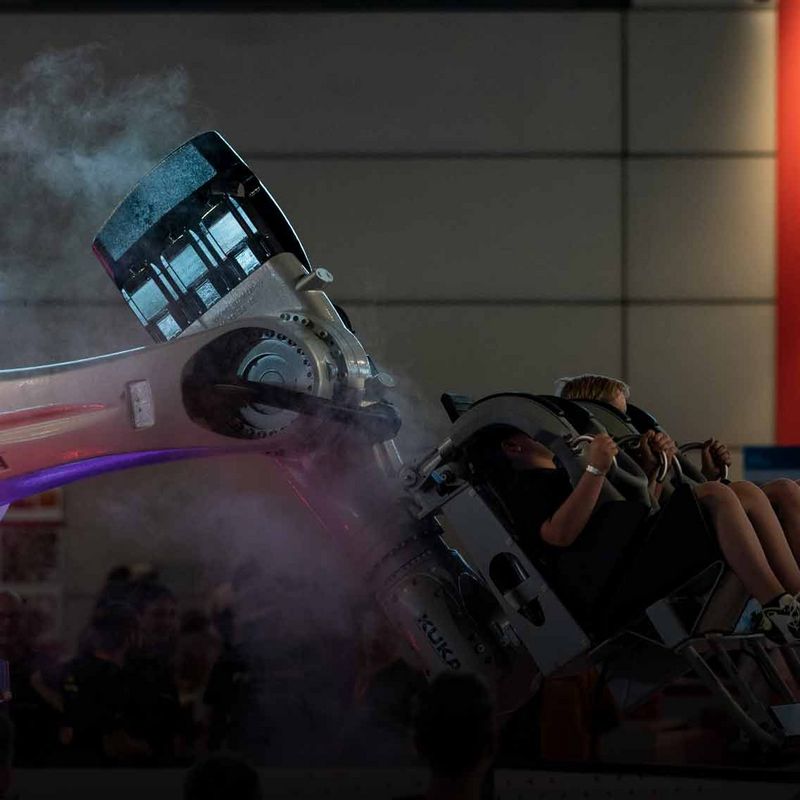18 July 2019
Shooting goals, dancing on the stage, saving lives – children and young people are training robots in all these skills for the European RoboCup Junior Championship. This year, the Championship for up and coming robotics experts took place during the IdeenExpo fair in Hannover for the first time. 500 girls and boys from 20 countries and between the ages of 10 and 19 built and programmed in Hannover to win the title. #explore was on the sidelines at the international Robot competitions.
As if by clockwork, the small robot approaches the ball over the grass-green pitch, wedges it between his grippers, steers past two electronic opponents and then pushes it over the line. Fabio, Patrik and Maximilian throw their arms into the air at the edge of the field: goal for Team Trash from Austria! When the referee blows his whistle shortly afterwards, it is unfortunately not quite enough. A close run thing: the opposing team from Croatia wins the game 4:3. But Team Trash is nevertheless not completely downhearted, for the competition is strong, after all. And they are going in the right direction, says Patrik Baranyi. “We have been able to improve our robots considerably compared to recent competitions”, says the twelve year old.
© Oliver HardtTeam Trash from St. Pölten in Austria: Maximilian Schuh, Patrik Baranyi and Fabio Berger.
The three pupils from St. Pölten in Lower Austria prepared for the tournament for four months, and built and coded every two weeks. At the end of April, they entered the Austrian Championships in Innsbruck. By winning the title in their age class - up to 14 years of age - they qualified for the European Championships. Now they are here in Hannover in order to compete against the best teams from 20 different countries and to push the ball over their opponents' goal line as often as possible. In the so-called Lightweight League, the goal line sends out infrared signals which the robots recognise with corresponding sensors. “And a compass sensor then ensures that the robot steers into the correct goal” explains twelve-year-old Fabio Berger. His team mate Maximilian Schuh explains that it is difficult to adjust this sensor correctly: “The robot motors generate a magnetic field, and that can interfere with the compass sensor.” The result: the robot loses its sense of direction and no longer knows where it is going.
Playfully into IT
So that everyone in the team knows what has to be done and at what point in the competition, they have divided up the roles: Fabio is the team leader and builds the robots, Maximilian is in charge of programming. “And I am the sidekick”, says Patrik and laughs. In other words: he supports the others with everything that comes up. He has been involved in robo soccer for about a year. And he certainly has IT knowhow to offer. “I programmed with Java before I joined the team”, he says. Fabio and Maximilian got their programming experience at the RoboCup. Maximilian has the most experience: he has already been building robots for three years. And what does he enjoy about it most? “Watching the robots playing football is the coolest thing!” Because that is when the autonomous robots demonstrate what has been taught to them by playing on the field itself. Building and programming correctly is not a matter of theory alone – it can be seen quite clearly in practice. And the aim is to bring children and young people into the worlds of technology and programming in a way that is also fun. This is the basic idea behind the RoboCup Junior and it is also shared by TÜV NORD, the premium sponsor of this year’s event.
© Oliver HardtTrying things out and coding right up to the kickoff: competitors use test arenas to try out and improve the construction and programming of the robots.
And the opportunity attracts lively interest when it comes to school pupils. “We have already been offering robotics at school level for several years and it has really developed well”, says teacher Barbara Gram, who mentors the team. Each year, than 30 children register for robotics classes at the grammar school in Josefstraße. In 2017 a team from the school actually became robo soccer world champions in Nagoya in Japan. A success which obviously left them wanting more. The pupils from the team plan to work in the technical field in future, and also do a great deal of programming in their spare time, reports Barbara. And as she says, “It is great that so many continue with it after school”.
© Oliver HardtDoes the program work? Michael Denisenkov and David Beitmann.
The three boys from Team Trash now also enjoy other types of coding beyond the RoboCup. “At the moment we are just programming a computer game in the ‘Unity’ game engine”, says Patrik. They still have quite a lot to do until it is finished, but they are used to that from working with the robots – because the robots are never really finished. “Often it only becomes clear at the games themselves what the robots can do even faster, more reliably and better”, explains Fabio. “This is why the robot changes every ten minutes.”
Robots need sunshades
The Jump Prime team from Essen are also currently working on their robot. “I started yesterday and first programmed the ball search and the compass sensor”, explains 13-year-old Michael and points to his laptop screen. Using the compass sensor, he can specify that the robot automatically only aims at the opposing goal. “Unless you make a mistake, and then he could shoot an own goal”, says Michael, laughing. In fact, team leader Anna is mainly responsible for programming. But at the moment she is building a kind of sunshade for the robot. The strong vertical light in the hall interferes with the sensors. “And then it is more difficult for the robot to find its way”, explains the 15-year-old. She came to programming through her brother who had been programming robots for some time. Now she has been taking part in the RoboCup for several years. “If you find mistakes and then correct them and the robot gets better, it is really great”, she says, explaining why she is fascinated by her electronic hobby.
© Oliver HardtTeam Jump Prime from Essen: Valentin Getzlaff, Michael Denisenkov, Anna Mankowski and David Beitmann.
Anna and her team mates seem to be good at finding and correcting mistakes. During the World Robot Olympiad (WRO), another robot competition, they reached the world finals in the Philippines. “And we came in third”, explains 11-year-old David proudly. And the young robotics enthusiasts see a lot of the world through the competitions. In May they were in Magdeburg for the RoboCup German Open. And after the European Championships in Hannover they will be going to the German Championships of the WRO.
© Oliver HardtElectronic star of the show: In the “On Stage” section of the competition, the robots dance and interact with the young people, following creative choreography.© Oliver HardtFingers crossed: when the autonomous robots are sent onto the track the quality of the construction and programming become obvious.
Dancing, lifesaving, staying in line
Football is not the only discipline where the robots shine in the RoboCup Junior: they also dance on stage with their coders, and after this entertaining phase of interaction between human and machine, a jury assesses the creativity and complexity of the choreography that has been programmed. At the other end of the hall, robots are currently saving human lives – or are at least training for a serious incident in the future. In the so-called Rescue League, they have to navigate through a simulated catastrophe landscape in order to rescue survivors. At the moment a robot is pushing itself up a ramp on the circuit, then hops over three humps, carefully circumnavigates a large plastic tin and turns back to a black line, which also gives this particular discipline its name. “In the rescue line exercise, the robots have to follow the black line and overcome obstacles, crossovers and gaps in the line”, explains Henrik Bremermann, who supports the competitions as a volunteer. The robots use light sensors in order to recognise the course of the line. The target is a room at the end of the circuit in which balls have to be collected and pushed into a black corner. “The balls represent our survivors, because the whole thing is meant to simulate a rescue situation”, adds Henrik. Each team can consider for itself how the robots can best do that. This means that the most varied equipment and methods are seen in the competition, aiming at bringing the “victims” into the evacuation zone.
© Oliver HardtRobo to the rescue: In the Rescue League, robots find a way through a simulated catastrophe area in order to rescue “victims”.
An independent route through the labyrinth
The queen of disciplines for the rescue robots is the so-called maze, or labyrinth, explains Henrik, and points to another track at the side of the competition arena. At first it does not look particularly spectacular, but it presents quite a challenge. Here, the robots have to find their way through a labyrinth but are not able to follow a line and have to orient themselves independently. “This is of course considerably more complicated”, says Henrik. “Some people make the robots create real maps in the process. Then they can calculate which places in the labyrinth they have not yet visited and still have to investigate.” And there is yet another element to face: the “victims” here incorporate heating elements which therefore have to be identified by means of their body heat. When the robots have found them using heat sensors or cameras, they have to give a signal and throw down a rescue pack. Henrik Bremermann has already built such rescue robots himself. In 2015 and 2016 he entered Rescue Line with a team, and last year he participated in the Maze. He and his team mate Gero Ahting set themselves a particularly difficult task: instead of using Lego, Fischertechnik or other ready-made elements, the pupils from Rastede near Oldenburg built their entire robot themselves. It meant a great deal of work, which was then rewarded with the German Championship title itself. For reasons of time, Henrik Bremermann then put his active robo building career on ice. But he still wanted to be part of the action, and so now participates as a volunteer in the RoboCup. “I can’t completely live without it”, says Henrik and laughs.
